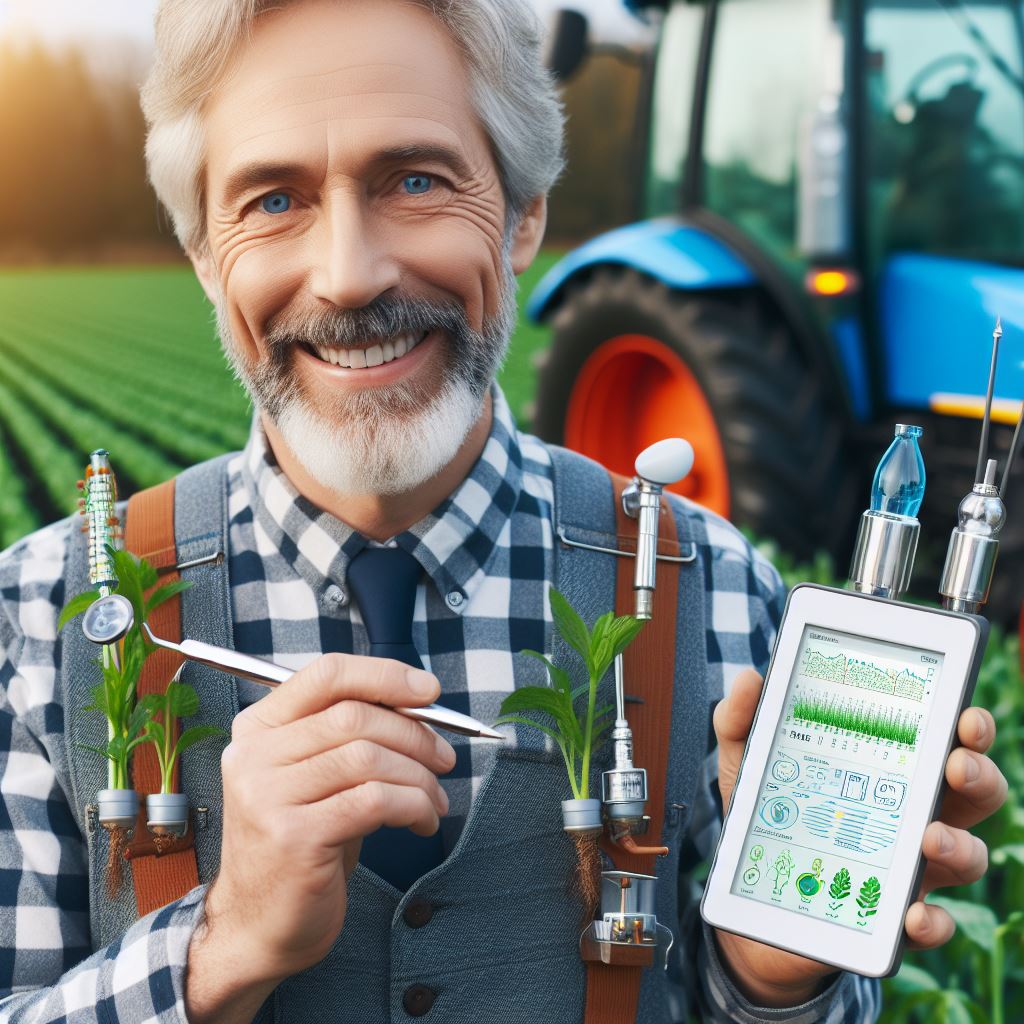Introduction
Climate Smart Agri Tools and Techniques encompass farming practices geared towards sustainably increasing productivity, enhancing resilience, and minimizing emissions in agriculture.
As climate change threatens agricultural yields worldwide, adopting climate-smart techniques is critical for feeding growing populations.
This blog post will introduce climate-smart agriculture and discuss tools farmers can utilize to mitigate climate impact.
Importance of implementing climate-smart techniques in farming
Climate-smart agriculture aims to tackle three challenges: sustainably improving agricultural productivity, adapting to climate change, and reducing greenhouse gas emissions from agriculture.
It integrates technologies and practices like conservation farming, improved water management, and renewable energy to optimize production, maximize efficiency, and build climate resilience.
Climate-smart systems take local contexts into account to identify solutions tailored for specific regions and crops.
With climate change expected to disrupt rainfall patterns, heat waves, and pest pressures globally, the need for adaptation is urgent.
Climate-smart tools allow farmers to continue providing food security by making their operations resilient against climate stressors.
Precision agriculture, alternative wetting and drying for rice, and index-based weather insurance are examples of innovations that can strengthen resilience.
Purpose of the blog post
This blog post will delve into major climate-smart techniques that can help farmers safeguard productivity and livelihoods against climate change impact.
The targeted solutions discussed will provide farmers actionable ways to start implementing climate-smart practices suitable for their operations.
Understanding Climate-Smart Agriculture
Climate-Smart Agriculture is an innovative and sustainable approach that aims to transform agricultural practices to mitigate and adapt to climate change while ensuring increased productivity and improved livelihoods for farmers.
Understanding the principles and benefits of Climate-Smart Agriculture is crucial for developing effective strategies and tools to address the challenges posed by climate change.
Definition and Principles
The three pillars of Climate-Smart Agriculture are productivity, adaptation, and mitigation.
Productivity focuses on increasing agricultural yields and production to meet the growing global food demand.
Transform Your Agribusiness
Unlock your farm's potential with expert advice tailored to your needs. Get actionable steps that drive real results.
Get StartedAdaptation aims to enhance the resilience of farming systems to climate change impacts, such as extreme weather events and changing rainfall patterns.
Mitigation involves reducing greenhouse gas emissions and promoting carbon sequestration through sustainable farming practices.
To ensure the successful implementation of Climate-Smart Agriculture, the triple-win approach is adopted.
This approach seeks to achieve three simultaneous and interconnected goals – social, economic, and environmental benefits.
By integrating these three dimensions, Climate-Smart Agriculture not only addresses climate change challenges but also improves farmer incomes, food security, and ecosystem sustainability.
Benefits of Climate-Smart Agriculture
Climate-Smart Agriculture offers numerous benefits that contribute to sustainable agricultural development and climate resilience.
- Improved yields and productivity: By adopting Climate-Smart Agricultural practices, farmers can enhance their crop yields and overall productivity. Integrated soil management, water conservation techniques, and improved crop varieties ensure better resource use efficiency and higher output.
- Enhanced resilience to climate change impacts: Climate-Smart Agriculture equips farmers with strategies to cope with climate variability and change. Diversification of crops, integrated pest management, improved water management, and agroforestry practices help farmers mitigate the risks associated with extreme weather events and other climate-related disturbances.
- Reduced greenhouse gas emissions: Climate-Smart Agriculture practices promote sustainable and low-carbon farming systems. By adopting practices like conservation agriculture, agroforestry, and precision irrigation, farmers can reduce greenhouse gas emissions, particularly carbon dioxide, nitrous oxide, and methane. These practices also contribute to carbon sequestration, helping to mitigate climate change.
Generally, Climate-Smart Agriculture is a holistic approach that addresses the challenges posed by climate change while ensuring sustainable agricultural development.
By focusing on the pillars of productivity, adaptation, and mitigation, and adopting the triple-win approach, Climate-Smart Agriculture offers improved yields and productivity, enhanced resilience to climate change impacts, and reduced greenhouse gas emissions.
It is essential for policymakers, researchers, and farmers to embrace Climate-Smart Agriculture and implement innovative tools and techniques to build a climate-resilient and sustainable agricultural sector.
Read: Solar-Powered Irrigation: A Deep Dive
Tools for Climate-Smart Agriculture
Climate-smart agriculture requires a set of tools and techniques that enable farmers to adapt to and mitigate the impacts of climate change.
In this section, we will explore some key tools that can support climate-smart farming practices.
Sustainable Land Management Techniques
Conservation agriculture practices
Conservation agriculture practices focus on nurturing soil health and reducing erosion and nutrient loss.
By minimizing tillage and using cover crops, farmers can improve soil structure and organic matter content.
This enhances soil water-holding capacity and reduces the risk of water runoff and soil erosion.
Agroforestry systems
Agroforestry systems offer an integrated approach to land use, combining trees and crops in the same area.
Trees provide shade, shelter, and additional income from timber and fruits.
They also help improve soil fertility by fixing nitrogen and enhancing nutrient cycling.
Agroforestry systems contribute to biodiversity conservation and promote resilience against climate change impacts.
Soil and water conservation methods
Soil and water conservation methods are essential for preventing soil degradation and water runoff.
Techniques like contour plowing, terracing, and windbreaks help reduce soil erosion and minimize the loss of nutrients, organic matter, and water.
These practices maintain soil health, promote water infiltration, and contribute to ecosystem resilience.
Precision Agriculture Technologies
Remote sensing and satellite imagery
Precision agriculture technologies enable farmers to optimize resource use and minimize inputs while maximizing productivity.
Remote sensing and satellite imagery provide valuable information about crop health, allowing farmers to detect any changes in vegetation and address problems in a timely manner.
Showcase Your Farming Business
Publish your professional farming services profile on our blog for a one-time fee of $200 and reach a dedicated audience of farmers and agribusiness owners.
Publish Your ProfileBy identifying areas of poor growth or stress, farmers can target interventions more effectively.
GPS-guided machinery
GPS-guided machinery allows precise application of inputs such as fertilizers and pesticides, minimizing wastage and reducing environmental impacts.
Farmers can create site-specific management plans based on real-time data, ensuring that inputs are applied only where and when needed.
This technology also saves time and labor, increasing operational efficiency.
Variable rate technology for inputs
Variable rate technology (VRT) further enhances precision agriculture by allowing farmers to adjust input application rates based on specific field conditions.
VRT takes into account factors like soil fertility, plant nutrient requirements, and crop growth stage to optimize resource allocation.
By tailoring inputs to the specific needs of different areas within a field, farmers can improve productivity and minimize resource wastage.
Climate Information Services
Accessing weather forecasts and climate data
Access to weather forecasts and climate data is crucial for farmers to plan their operations effectively.
By knowing about upcoming weather conditions and long-term climate trends, farmers can make informed decisions regarding planting, irrigation, and harvesting.
This helps avoid potential losses and optimize resource allocation.
Utilizing climate models and prediction tools
Utilizing climate models and prediction tools can provide valuable insights into future climate scenarios and their potential impacts on agriculture.
Farmers can assess the vulnerability of their farms and adopt appropriate adaptation strategies.
This knowledge can also inform long-term planning, such as crop diversification or changes in production systems.
Integrating climate information into decision-making processes
Integrating climate information into decision-making processes enables farmers to manage risks and capitalize on opportunities.
By considering climate projections alongside economic and social factors, farmers can develop robust strategies for coping with climate change.
This integration facilitates resilience-building and fosters sustainable agricultural practices.
In short, climate-smart agriculture relies on the effective use of tools and techniques that enhance productivity, reduce environmental impacts, and build resilience.
Sustainable land management techniques, precision agriculture technologies, and climate information services all play essential roles in facilitating climate-smart farming practices.
By adopting these tools, farmers can navigate the challenges of climate change and create a more sustainable and productive agricultural sector.
Read: Agri Robots: The Future of Farming Now
Techniques for Climate-Smart Agriculture
Crop Diversification and Rotation
Benefits of diversifying crop species
Diversifying crop species within agricultural systems offers numerous benefits.
It enhances resilience to climate change by minimizing risks associated with mono-cropping.
By cultivating a variety of crops, farmers can minimize losses caused by specific climatic conditions such as drought or excessive rainfall.
Additionally, diversification reduces vulnerability to pests and diseases, as different crops have varying resistance levels.
This approach also increases agricultural productivity by optimizing resource utilization and nutrient cycling in the soil.
Crop diversification is an essential technique for achieving climate-smart agriculture.
Importance of crop rotation in soil health and pest/disease management
Another critical technique for climate-smart agriculture is crop rotation.
Crop rotation involves alternating the cultivation of different crops on the same piece of land over a defined period.
This practice improves soil health by preventing the buildup of specific pathogens that target specific plant species.
It also reduces pest populations as pests that are specific to one crop may decline during non-host crop cycles.
Additionally, crop rotation enhances nutrient availability in the soil, minimizing the need for synthetic fertilizers.
By promoting soil health and pest/disease management, crop rotation contributes to sustainable agricultural practices.
Water Management Strategies
Efficient irrigation techniques
Efficient water management is crucial for climate-smart agriculture.
Implementing irrigation techniques that optimize water use is vital for sustainable agricultural production.
Drip irrigation and precision sprinkler systems ensure water is supplied directly to plant roots, minimizing evaporation and maximizing water absorption.
These techniques improve water use efficiency, reduce water waste, and save resources.
Rainwater harvesting and water storage
In addition to efficient irrigation techniques, rainwater harvesting and water storage systems play a vital role in climate-smart agriculture.
Collecting rainwater during periods of rainfall and storing it for later use helps mitigate water scarcity issues, especially in regions with irregular rainfall patterns.
Water storage systems can range from simple storage barrels to larger reservoirs or underground tanks.
By capturing rainfall, farmers can ensure a consistent water supply for irrigation, reducing dependency on external water sources.
Showcase Your Farming Business
Publish your professional farming services profile on our blog for a one-time fee of $200 and reach a dedicated audience of farmers and agribusiness owners.
Publish Your ProfileIncorporating drought-tolerant crops
Furthermore, incorporating drought-tolerant crops is crucial for climate-smart agriculture.
These plant species are adapted to thrive with minimal water availability, making them resilient to drought conditions.
By growing crops that can withstand water stress, farmers can minimize yield losses during periods of low rainfall or water scarcity.
Drought-tolerant crops, such as millets or certain varieties of sorghum, offer opportunities for sustainable agriculture in regions prone to erratic or limited water availability.
Agroecological Approaches
Organic farming practices
Agroecological approaches focus on sustainable farming practices that minimize environmental impact.
Organic farming practices avoid synthetic fertilizers and pesticides, relying instead on natural inputs such as compost and manure.
By prioritizing soil health and biodiversity, organic farming promotes long-term sustainability, reduces pollution, and protects ecosystems.
Integrated pest management (IPM)
Integrated pest management (IPM) methods are vital for climate-smart agriculture.
IPM combines biological, cultural, and chemical control strategies to manage pests effectively while minimizing ecological risks.
By using insect traps, pheromone lures, and natural predators, farmers can keep pest populations under control without depending solely on chemical pesticides.
IPM enables the cultivation of healthy crops while minimizing environmental harm.
Biological control of pests and diseases
Biological control of pests and diseases plays a significant role in climate-smart agriculture.
Instead of relying on chemical interventions, farmers use beneficial organisms to suppress pests and diseases.
For example, introducing predatory insects, such as ladybugs or parasitic wasps, can help control pest populations.
This approach ensures a balanced ecosystem, reducing the need for chemical pesticides and promoting sustainable agriculture.
In general, climate-smart agriculture requires the adoption of various techniques.
Crop diversification and rotation, water management strategies, and agroecological approaches contribute to sustainable farming practices.
By implementing these techniques, farmers can enhance resilience, improve productivity, reduce environmental impact, and adapt to the challenges posed by climate change.
Read: Next-Gen Drip Irrigation: What’s New?

Challenges and Opportunities in Adopting Climate-Smart Agriculture
Barriers to Implementation
- Lack of awareness and knowledge: Farmers often lack the necessary information and understanding about climate change and its impacts on agriculture.
- Limited access to financial resources and technology: The cost of implementing climate-smart agriculture practices can be a major barrier for small-scale farmers with limited funds.
- Institutional and policy constraints: Inadequate policies and institutional frameworks can hinder the adoption of climate-smart agriculture at a larger scale.
Potential Solutions
- Strengthening extension services and farmer training: Providing farmers with access to training programs and extension services can enhance their knowledge and skills in implementing climate-smart practices.
- Promoting public-private partnerships: Collaboration between governments, private sector companies, and farmers can help bridge the gap in accessing financial resources and technology.
- Facilitating supportive policies and incentives: Governments should create favorable policies, such as subsidies and incentives, to encourage farmers to adopt climate-smart agriculture.
By addressing these challenges and leveraging the opportunities, the adoption of climate-smart agriculture can be enhanced.
The benefits can include increased agricultural productivity, resilience to climate change impacts, and reduced greenhouse gas emissions.
Furthermore, climate-smart agriculture can contribute to food security, poverty reduction, and sustainable development.
Different regions and contexts may face unique challenges
However, it is important to recognize that different regions and contexts may face unique challenges.
Thus, tailor-made approaches and strategies should be developed to address the specific barriers and opportunities within each locality.
Partnerships between governments, research institutions, civil society organizations, and farmers’ networks are key to implementing climate-smart agriculture successfully.
These collaborations can support capacity-building, knowledge sharing, and innovation in sustainable farming practices.
In essence, the adoption of climate-smart agriculture requires a collective effort.
It necessitates the active involvement and cooperation of all stakeholders to overcome barriers and seize opportunities for a more sustainable and resilient agriculture sector.
As awareness and understanding of climate change continue to grow, so does the urgency to transition into climate-smart agriculture.
By investing in the necessary tools, technologies, and policies, we can pave the way for a more sustainable and resilient agriculture sector that can mitigate and adapt to climate change.
Together, we can build a future where agriculture not only feeds the world but also safeguards the health of our planet for generations to come.
Read: Smart Sensors: Changing Farm Water Use
Uncover the Details: Breakthroughs in Soil Health: Agri-Tech’s Role
Conclusion
Recap of the importance of climate-smart agriculture
Climate-smart agriculture plays a crucial role in addressing the challenges posed by climate change.
By adopting these innovative tools and techniques, farmers can significantly mitigate the environmental impact of their practices while ensuring sustainable productivity.
Encouragement for farmers to adopt these tools and techniques
It is essential for farmers to recognize the importance of climate-smart agriculture and embrace these tools and techniques in their farming operations.
This will not only help them adapt to changing climate conditions but also enhance their resilience and improve their livelihoods.
Call to action for policymakers and stakeholders
Moreover, a call to action is necessary for policymakers and stakeholders to support climate-smart agriculture initiatives.
Adequate financial and technical assistance should be provided, along with the necessary policy frameworks, to encourage widespread adoption of these practices.
By investing in research and development, promoting capacity-building programs, and incentivizing farmers, policymakers and stakeholders can help create an enabling environment for climate-smart agriculture.
Showcase Your Farming Business
Publish your professional farming services profile on our blog for a one-time fee of $200 and reach a dedicated audience of farmers and agribusiness owners.
Publish Your ProfileThis will further contribute to global efforts in achieving sustainable development goals and mitigating climate change.
In a nutshell, the transition towards climate-smart agriculture is essential for our future food security, environmental sustainability, and the well-being of farmers.
Let us join hands and work together to make this vision a reality.
Together, we can ensure a resilient and sustainable agricultural sector for generations to come.




